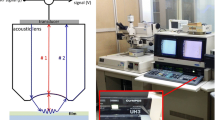Abstract
In this article, we investigate the effect of thermal treatment on a piezoelectric material, zinc oxide, which has found numerous applications in sensors and actuators. Even though the exact mechanisms rendering electrical properties are less known, we suspect that the thermal treatments are responsible for improvement of electrical characteristics of the deposited thin films. We establish that the thermal agitation is responsible for improvement of orders of magnitude in electrical characteristics of sputtered ZnO thin films. The surface quality of the thin films deposited is process dependent. ZnO films were deposited using a dielectric sputtering method, on oxidized silicon 100 n-type wafers. Further, these films were thermally annealed in oxygen ambient at 600 °C in a tube furnace with 2 mL/min pressure. It is observed that, after thermal annealing, the quality of the films is improved by orders of magnitude. The luminance, crystalline quality, and surface morphology of these thin films was measured with atomic force microscopy, scanning electron microscopy with BSD detector (BSD-SEM), and Fourier transform infrared spectroscopy (FTIR). The results infer that the film’s surface is very smooth and dense. The surface roughness is improved by 1.3149 nm from 7.882 nm prior to thermal annealing to post-annealing surface roughness with 6.5671 nm. Post-thermal annealing process reveals average grain size was 50 nanometers; the surface roughness is reduced to 6.5671 nm. A significant improvement in electrical current-voltage characteristics was recorded with I-V curve. It is suspected to be due to substantial enhancement in electrical conductivity as a result of thermal treatment and improved spectral response recorded a FTIR peak shift of 1 wave number in total. The FTIR peak shift is suspected to be due to evaporation and reduction in oxygen vacancies due to thermal annealing process. The post-annealed ZnO films will be used for actuation in the future.










Similar content being viewed by others
References
Ü. Özgür, Y.I. Alivov, C. Liu, A. Teke, M.A. Reshchikov, S. Doğan, V. Avrutin, S.-J. Cho, H. Morkoç, A comprehensive review of ZnO materials and devices. J.Appl. Phys. 98, 041301 (2005). doi:10.1063/1.1992666
D.R. Doutt, C. Zgrabik, H.L. Mosbacker, L.J. Brillson, Impact of near-surface native point defects, chemical reactions, and surface morphology on ZnO interfaces. J. Vac. Sci. Technol. B 26, 1477–1482 (2008). doi:10.1116/1.2919158
S.A. Studenikin, N. Golego, M. Cocivera, Optical and electrical properties of undoped ZnO films grown by spray pyrolysis of zinc nitrate solution. J. Appl. Phys. 83, 2104–2111 (1998). doi:10.1063/1.366944
S.J. Baik, J.H. Jang, C.H. Lee, W.Y. Cho, K.S. Lim, Highly textured and conductive undoped ZnO film using hydrogen post-treatment. Appl. Phys. Lett. 70, 3516–3518 (1997). doi:10.1063/1.119218
S.Y. Myong, K.S. Lim, Highly stable and textured hydrogenated ZnO thin films. Appl. Phys.Lett. 82, 3026–3028 (2003). doi:10.1063/1.1571651
G. Xiong, J. Wilkinson, B. Mischuck, S. Tüzemen, K.B. Ucer, R.T. Williams, Control of p- and n-type conductivity in sputter deposition of undoped ZnO. Appl. Phys. Lett. 80, 1195–1197 (2002). doi:10.1063/1.1449528
S. Cho, J. Ma, Y. Kim, Y. Sun, G.K.L. Wong, J.B. Ketterson, Photoluminescence and ultraviolet lasing of polycrystalline ZnO thin films prepared by the oxidation of the metallic Zn. Appl. Phys. Lett. 75, 2761–2763 (1999). doi:10.1063/1.125141
M.W. Zhu, J. Gong, C. Sun, J.H. Xia, X. Jiang, Investigation of correlation between the microstructure and electrical properties of sol-gel derived ZnO based thin films. J. Appl. Phys. 104, 073113 (2008). doi:10.1063/1.2993978
L. Don, Piezoelectric thin film micromechanical beam resonators. Sensors Actuators A Phys. 88(3, 5), 263–272 (2001). doi:10.1016/S0924-4247(00)00518-5. ISSN 0924–4247
P.R. Apte, U.D. Vaishnav, S.G. Lokhare, V.R. Palkar, S.M. Pattalwar, Micromechanical components with novel properties. Proc. SPIE 3321, 287–297 (1996)
M.J. Madou, Fundamentals of micro-fabrication: the science of miniaturization (Academic, New York, 2002)
T. Xu, G. Wu, G. Zhang, Y. Hao, The compatibility of ZnO piezoelectric film with micromachining process. Sensors Actuators A 104, 61–67 (2003)
S. Tadigadapa, K. Mateti, Piezoelectric MEMS sensors: state-of-the-art and perspectives. Meas. Sci. Technol. 20, 092001 (2009)
C. Jagadish, S. Pearton, Zinc oxide bulk films and nanostructures (Elsevier, London, 2006)
T. Shibata, K. Unno, E. Makino, Y. Ito, S. Shimada, Characterization of sputtered ZnO film as sensor and actuator for diamond AFM probe. Sensors Actuators A 102, 106–113 (2002)
I. Horcas, R. Fernandez, J.M. Gomez-Rodriguez, J. Colchero, J. Gomez-Herrero, A.M. Baro, Rev. Sci. Instrum. 78, 013705 (2007)
Acknowledgments
The authors would like to thank the Microelectronics Group, Nanoelectronics Center, Department of Electrical Engineering, Department of Chemistry, Department of Physics, Suman Mashruwala Micromachining Laboratory, Department of Mechanical Engineering, Indian Institute of Technology Bombay, Powai, Mumbai. The authors sincerely thank the Centre of Excellence in Nanoelectronics, IIT Bombay for providing them the instrumental facilities under the Indian Nanoelectronics Users’ Program (INUP) of the Department of Information Technology, Government of India.
Authors’ Contributions
ASK carried out the preparation of the ZnO films, participated in the characterization of the ZnO films, and drafted the manuscript. PRA conceived the study and participated in its design and experimentation. SD participated in the characterization of the ZnO films and the coordination. All authors read and approved the final manuscript.
Conflict of Interest
The authors declare that they have no competing interests.
Author information
Authors and Affiliations
Corresponding author
Rights and permissions
About this article
Cite this article
Kurhekar, A., Apte, P.R. & Duttagupta, S. Growth and Characterization of High-Quality Dielectric Sputtered Zinc Oxide Films from the First Principle. Braz J Phys 44, 665–672 (2014). https://doi.org/10.1007/s13538-014-0251-5
Received:
Published:
Issue Date:
DOI: https://doi.org/10.1007/s13538-014-0251-5




